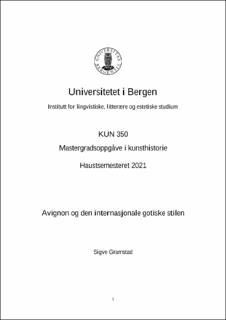| dc.contributor.author | Gramstad, Sigve | |
| dc.date.accessioned | 2021-12-21T00:47:11Z | |
| dc.date.available | 2021-12-21T00:47:11Z | |
| dc.date.issued | 2021-11-23 | |
| dc.date.submitted | 2021-12-20T23:00:06Z | |
| dc.identifier.uri | https://hdl.handle.net/11250/2835157 | |
| dc.description.abstract | Oppgåva undersøkjer om Avignon i pavetida først på 1300-talet var ein fødestad for den internasjonale gotiske stilen. Avignon og kunsten i byen på den tida blir presentert, den same gjeld for den internasjonale stilen og sentrale kunstverk i stilen. Drøftinga på det grunnlaget konkluderer med at Avignon på denne tida var ein fødestad for stilen. | |
| dc.description.abstract | The thesis investigates if papal Avignon (1320-1360) was a birthplace of the International Gothic Style. After the popes settled in Avignon, the city became a religious and political centre in Europe. During the period an extensive construction work took place, and the new churches, cloisters and palaces needed artistic decoration. Artists from all parts of Europe came to Avignon to work, and representatives of royal and other centres in Europe visited the Pope. Avignon’s prestige and the wealth of paintings there made it possible to influence later works of art. The thesis presents examples of art that were in Avignon in the period. Most of the art from that time is lost or destroyed. The surviving art gives nevertheless an impression of a vibrant art scene, influenced primarily by Italian and French art. The art is characterised by inventiveness, and one can observe more realism, a new palette of colours, the first realistic portraits after antiquity, a new approach to nature and a luxurious elegance in the portrayal of persons in the paintings. Many artistic elements were imported from Italian art and presented to new audiences. The thesis presents the International Gothic Style through descriptions by art historians who have been occupied with the style. There were also two exhibitions in 1962 dedicated to art in Europe around 1400, where many art pieces in the style were exhibited. The style is characterised by a new confidence in nature, a taste for beautiful flowering lines, an excessive refinement in proportions, behaviour and dress of the figures, of luxurious processions and throngs of people. Key pieces of art in the style are Les Très Riches Heures du duc de Berry and The Wilton Diptych. The aristocracy formed the main donator group, and realism is modified to satisfy the tastes of the donators. In addition, art in the style tends to visualise the difference between the aristocracy and other social classes in society. – The style is seldom mentioned in newer presentations of art from the period, where emphasis often is on the later renaissance. However, the style is useful when investigating art from around 1400. The thesis shows the connection between the art in Avignon and the International Gothic Style. Some paintings in the style are copies from or have been inspired by paintings from Avignon, and many elements from the art in Avignon can be found in art pieces in the later style. It is therefore reasonable to conclude that Avignon was a birthplace of the International Gothic Style. | |
| dc.language.iso | nno | |
| dc.publisher | The University of Bergen | |
| dc.rights | Copyright the Author. All rights reserved | |
| dc.subject | Simone Martini | |
| dc.subject | les très riches Heures du duc de Berry | |
| dc.subject | den internasjonale gotiske stilen | |
| dc.subject | Matteo Giovannetti | |
| dc.subject | Wilton-diptykonet | |
| dc.subject | Avignon | |
| dc.title | Avignon og den internasjonale gotiske stilen | |
| dc.title.alternative | Avignon and The International Gothic Style | |
| dc.type | Master thesis | |
| dc.date.updated | 2021-12-20T23:00:06Z | |
| dc.rights.holder | Copyright the Author. All rights reserved | |
| dc.description.degree | Kunsthistorie mastergradsoppgåve | |
| dc.description.localcode | KUN350 | |
| dc.description.localcode | MAHF-KUN | |
| dc.subject.nus | 713203 | |
| fs.subjectcode | KUN350 | |
| fs.unitcode | 11-21-0 | |
